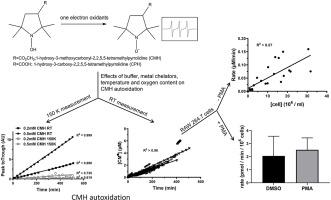当前位置:
X-MOL 学术
›
Free Radical Bio. Med.
›
论文详情
Our official English website, www.x-mol.net, welcomes your feedback! (Note: you will need to create a separate account there.)
Quantitation of spin probe-detectable oxidants in cells using electron paramagnetic resonance spectroscopy: To probe or to trap?
Free Radical Biology and Medicine ( IF 7.4 ) Pub Date : 2020-05-04 , DOI: 10.1016/j.freeradbiomed.2020.04.020 John P Gotham 1 , Rui Li 2 , Trent E Tipple 2 , Jack R Lancaster 3 , Taiming Liu 4 , Qian Li 2
Free Radical Biology and Medicine ( IF 7.4 ) Pub Date : 2020-05-04 , DOI: 10.1016/j.freeradbiomed.2020.04.020 John P Gotham 1 , Rui Li 2 , Trent E Tipple 2 , Jack R Lancaster 3 , Taiming Liu 4 , Qian Li 2
Affiliation

|
Electron Paramagnetic Resonance (EPR) spectroscopy coupled with spin traps/probes enables quantitative determination of reactive nitrogen and oxygen species (RNOS). Even with numerous studies using spin probes, the methodology has not been rigorously investigated. The autoxidation of spin probes has been commonly overlooked. Using the spin probe 1-hydroxy-3-methoxycarbonyl-2,2,5,5-tetramethylpyrrolidine (CMH), the present study has tested the effects of metal chelators, temperature, and oxygen content on the autoxidation of spin probes, where an optimized condition is refined for cell studies. The apparent rate of CMH autoxidation under this condition is 7.01 ± 1.60 nM/min, indicating low sensitivity and great variation of the CMH method and that CMH autoxidation rate should be subtracted from the generation rate of CMH-detectable oxidants (simplified as oxidants below) in samples. Oxidants in RAW264.7 cells are detected at an initial rate of 4.0 ± 0.7 pmol/min/106 cells, which is not considered as the rate of basal oxidants generation because the same method has failed to detect oxidant generation from the stimulation of phorbol-12-mysirate-13-acetate (PMA, 0.1 nmol/106 cells) in cells (2.5 ± 0.9 for PMA vs. 2.1 ± 1.5 pmol/min/106 cells for dimethyl sulfoxide (DMSO)-treated cells). In contrast, the spin trap 5,5-dimethyl-1-pyrroline-N-oxide (DMPO), which exhibits minimal autoxidation, reveals differences between PMA and DMSO treatment (0.26 ± 0.09 vs. -0.06 ± 0.12 pmol/min/106 cells), which challenges previous claims that spin probes are more sensitive than spin traps. We have also found that low temperature EPR measurements of frozen samples of CMH autoxidation provide lower signal intensity and greater variation compared to RT measurements of fresh samples. The current study establishes an example for method development of RNOS detection, where experimental details are rigorously considered and tested, and raises questions on the applications of spin probes and spin traps.
中文翻译:

使用电子顺磁共振波谱定量测定细胞中自旋探针可检测的氧化剂:探测还是捕获?
电子顺磁共振(EPR)光谱结合自旋阱/探针可以定量测定活性氮和氧种类(RNOS)。即使使用旋转探针进行了大量研究,该方法也没有经过严格的研究。旋转探针的自氧化通常被忽视。使用自旋探针1-hydroxy-3-methoxymethoxy-2,2,5,5-tetramethylpyrrolidine(CMH),本研究测试了金属螯合剂,温度和氧含量对自旋探针自氧化的影响,其中优化的条件可用于细胞研究。在此条件下,CMH自氧化的表观速率为7.01±1.60 nM / min,表示CMH方法的灵敏度低且变化很大,并且应从样品中CMH可检测的氧化剂(以下简称为氧化剂)的产生率中减去CMH自氧化率。以4.0±0.7 pmol / min / 106细胞的初始速率检测到RAW264.7细胞中的氧化剂,这不被视为基础氧化剂的生成速率,因为相同的方法未能检测到佛波醇-刺激下氧化剂的生成。细胞中的12-mysirate-13-acetate(PMA,0.1 nmol / 106细胞)(PMA为2.5±0.9,而二甲基亚砜(DMSO)处理的细胞为2.1±1.5 pmol / min / 106细胞)。相比之下,自旋陷阱5,5-二甲基-1-吡咯啉-N-氧化物(DMPO)表现出最小的自氧化作用,揭示了PMA和DMSO处理之间的差异(0.26±0.09对-0.06±0.12 pmol / min / 106细胞),这挑战了先前的说法,即自旋探针比自旋阱更敏感。我们还发现,与新鲜样品的RT测量相比,CMH自氧化冷冻样品的低温EPR测量提供了更低的信号强度和更大的变化。当前的研究为RNOS检测方法的开发建立了一个实例,其中严格考虑和测试了实验细节,并提出了有关自旋探针和自旋阱应用的疑问。
更新日期:2020-05-04
中文翻译:

使用电子顺磁共振波谱定量测定细胞中自旋探针可检测的氧化剂:探测还是捕获?
电子顺磁共振(EPR)光谱结合自旋阱/探针可以定量测定活性氮和氧种类(RNOS)。即使使用旋转探针进行了大量研究,该方法也没有经过严格的研究。旋转探针的自氧化通常被忽视。使用自旋探针1-hydroxy-3-methoxymethoxy-2,2,5,5-tetramethylpyrrolidine(CMH),本研究测试了金属螯合剂,温度和氧含量对自旋探针自氧化的影响,其中优化的条件可用于细胞研究。在此条件下,CMH自氧化的表观速率为7.01±1.60 nM / min,表示CMH方法的灵敏度低且变化很大,并且应从样品中CMH可检测的氧化剂(以下简称为氧化剂)的产生率中减去CMH自氧化率。以4.0±0.7 pmol / min / 106细胞的初始速率检测到RAW264.7细胞中的氧化剂,这不被视为基础氧化剂的生成速率,因为相同的方法未能检测到佛波醇-刺激下氧化剂的生成。细胞中的12-mysirate-13-acetate(PMA,0.1 nmol / 106细胞)(PMA为2.5±0.9,而二甲基亚砜(DMSO)处理的细胞为2.1±1.5 pmol / min / 106细胞)。相比之下,自旋陷阱5,5-二甲基-1-吡咯啉-N-氧化物(DMPO)表现出最小的自氧化作用,揭示了PMA和DMSO处理之间的差异(0.26±0.09对-0.06±0.12 pmol / min / 106细胞),这挑战了先前的说法,即自旋探针比自旋阱更敏感。我们还发现,与新鲜样品的RT测量相比,CMH自氧化冷冻样品的低温EPR测量提供了更低的信号强度和更大的变化。当前的研究为RNOS检测方法的开发建立了一个实例,其中严格考虑和测试了实验细节,并提出了有关自旋探针和自旋阱应用的疑问。



























 京公网安备 11010802027423号
京公网安备 11010802027423号